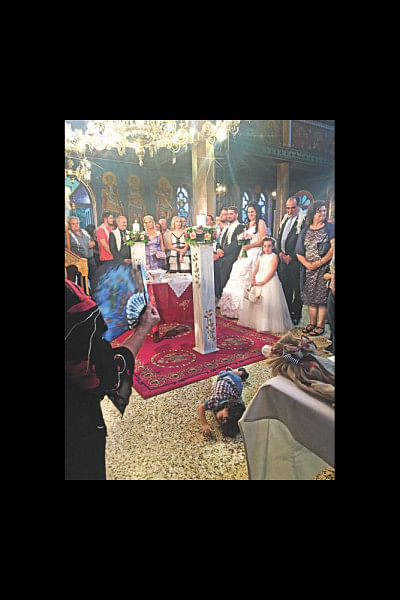The big Greek wedding

After spending a year on the island of Crete, attending a thoroughly traditional wedding that lasted till 7AM, and a more modern one in Athens, where the festivities wrapped up by 4AM, my take on Greek weddings is that they give our versions a stiff competition when it comes to rituals and traditions.
The movie 'My Big Fat Greek Wedding' was especially popular in our part of the world, as we could relate to the craziness and the many customs involved, but as Hollywood would also dearly like us to believe, all Greeks smash plates at their weddings.
Outside the major cities, Greece is still fiercely orthodox, and if you plan to get married back in your 'desher bari,' be prepared for a seriously long day. Greek weddings in the church last long enough to confuse you into thinking this is a Hindu marriage ceremony with all its incantations.
In Greek weddings, families from both sides are heavily involved and when they say everyone is invited to the dinner, they mean a crowd of anything between 800 to 2000 people, easily! Festivities begin around 5PM as the bride and the bridegroom start getting dressed. The friends of the groom gather around him, while the best man forges a stronger relationship by shaving him on this important day. The bride meanwhile is surrounded by all her girlfriends, who sing "simera gamos ginete" (there is a wedding today), as they help the bride on with her dress for the occasion.
The bride then puts on her shoes, aided by more friends, and this too is a special ritual. The names of all her single friends are written on the sole of the shoes, and the names that get rubbed off by the end of the day are the lucky ones.
The wedding party then ties ribbons to their cars, or for most of the usual affairs, they go to the venue in single file, honking all the way, in case anyone misses the fact that this is indeed a wedding procession!
The march heads inside the church or towards the official, presiding over the vows to be exchanged. For orthodox church weddings, the process is long, and requires a patient audience as the bride and the bridegroom go through a choreographed set of rituals, enveloped in the fragrance of incense and the heady mix of everyone's perfumes. They often hold candles during the ceremony, which are either taken back or left at the church as they are required to be burned out and never discarded.
At some point here, the best man takes over and passes the rings along to the about-to-be-newly-weds; this is passed along three times to symbolise how the weaknesses of one are compensated by the other, and vice versa. Similarly, the crown (stefana), goes around them thrice before being placed on the heads of the bride and the bridegroom.

The stefana is a tradition, possibly being carried forth from the ancient times when it was made of natural elements like olive leaves and vine, and lemon flowers dedicated to the goddess Aphrodite. Today, the crowns are joined by a ribbon.
Once the two are tied in matrimony, the newlyweds lead the way out and dance together, often in the church courtyard, with the rest of the family or close friends. There are a number of dances, but the most common ones involve everyone going around in a circle holding hands, set against the tunes of a traditional melody being played live.
But this is just the beginning of the party…
Back at the main venue, food is prepared to serve an entire village and all its neighbours. Even urban settings go for a large number of guests as people also bring their families along.
Ghammo Pilafi is rice gruel made with the butter of goat milk, and is served as a plain side with the tonnes of meat that load the tables. Boiled with minimal herbs or simply grilled, mutton and beef, or pork — all make an appearance accompanied by an assortment of salads that could vary from leafy green ones doused in olive oil, to Greek salads with a slab of feta cheese on top.
Some more greens may follow, which are simply blanched and served with a dash of olive oil and a squirt of lemon juice to add that extra tanginess.
The entire affair is basically an ode to meat and as a guest, you are expected to do your bit and cover every possible empty space of your plate with it!
Desserts arrive in all their honeyed sweetness. In some weddings where a cake has been cut, it is served at some point in the wee hours of the morning when the guests are exhausted after all the dancing.
At weddings, the Greeks literally dance all night. The party is known to last until the first rays of sunlight, but live music continues and the dancing in partial semi-circles is accentuated as each dancer at the end of the circle does an extra bit of dance that requires enough energy to convince you that the food consumed was burnt off already.
Gifts are common at weddings —cash given in fancy envelopes to the newlyweds being one of the most common. This is not only to help the young couple out with expenses, but in earlier days, relatives or close friends would be asked to provide certain things required for the new home.
Even today, weddings in Greece are a fairly grand affair which is why it is now common to have a civil marriage and save up for a grand reception later (often combined with the christening of their first born, saving money and time).
Photo courtesy: Reema Islam

 For all latest news, follow The Daily Star's Google News channel.
For all latest news, follow The Daily Star's Google News channel. 



Comments